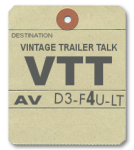Painting using exterior automotive/ fleet paint. A tutorial
Aug 6, 2018 10:33:06 GMT -8
RinTin likes this
Post by Alaska Shasta on Aug 6, 2018 10:33:06 GMT -8
I wanted to offer up some information about exterior automotive/ fleet paint and primer. I have been involved with automotive paint since 1979 in sales and application. This info is just on auto/ fleet paint, not latex house paint.
Here is a simple breakdown.
Paint will come in either single stage, or basecoat/ clearcoat. Single stage does not require a clearcoat, whereas BC/CC does require a clearcoat for UV protection and gloss.
“Single stage” is usually found in 3 quality levels. Alkyd enamel, also known as synthetic enamel, Acrylic enamel, and Urethane. These are listed in ascending levels of quality and price. The alkyd and acrylic enamels may or may not require a hardener, or catalyst. The catalyst binds the paint molecules together making it a superior coating. The urethane will usually always require a hardener. Personally, I would never spray an automotive paint without the catalyst since it makes the final finish far more durable and longer lasting.
“Basecoat/ Clearcoat” will have a base of color, and then followed up with the clearcoat. In the automotive world this works good for speed of productivity, and the ability to polish out small blemishes in the clearcoat without disturbing the base color.
Single stage works well if you are spraying a solid, non-metallic color. Where the BC/CC works best with metallic colors since the basecoat dries so fast it locks the orientation of the metallic particles down much quicker. In the single stage metallics, the metallic particle can swim around much longer and cause mottling, or cloudiness. BC/CC is also good for solid colors.
Primer will be needed for bare aluminum or steel for optimal adhesion results prior to top coating with the final color. On bare aluminum or steel the choices are an etching primer, or an epoxy primer. The epoxy primer is usually good enough for adhesion, but the etching primer will add an improved level of corrosion protection. The etching primer will likely need to be primed with an epoxy or “Build primer”. Epoxy primer is generally not a primer that is intended to be sanded. If you need to prime bodywork areas, or areas with small imperfections, a “Build primer” will be needed. This is a primer with a much higher percentage of resin so as to give you a thicker primer film thickness. This build primer will need to be sanded prior to applying the final paint, whereas the epoxy primer can be usually be top coated without sanding if top coated within the acceptable timeframe specified by the manufacturer.
I hope this was helpful. Bryan
Here is a simple breakdown.
Paint will come in either single stage, or basecoat/ clearcoat. Single stage does not require a clearcoat, whereas BC/CC does require a clearcoat for UV protection and gloss.
“Single stage” is usually found in 3 quality levels. Alkyd enamel, also known as synthetic enamel, Acrylic enamel, and Urethane. These are listed in ascending levels of quality and price. The alkyd and acrylic enamels may or may not require a hardener, or catalyst. The catalyst binds the paint molecules together making it a superior coating. The urethane will usually always require a hardener. Personally, I would never spray an automotive paint without the catalyst since it makes the final finish far more durable and longer lasting.
“Basecoat/ Clearcoat” will have a base of color, and then followed up with the clearcoat. In the automotive world this works good for speed of productivity, and the ability to polish out small blemishes in the clearcoat without disturbing the base color.
Single stage works well if you are spraying a solid, non-metallic color. Where the BC/CC works best with metallic colors since the basecoat dries so fast it locks the orientation of the metallic particles down much quicker. In the single stage metallics, the metallic particle can swim around much longer and cause mottling, or cloudiness. BC/CC is also good for solid colors.
Primer will be needed for bare aluminum or steel for optimal adhesion results prior to top coating with the final color. On bare aluminum or steel the choices are an etching primer, or an epoxy primer. The epoxy primer is usually good enough for adhesion, but the etching primer will add an improved level of corrosion protection. The etching primer will likely need to be primed with an epoxy or “Build primer”. Epoxy primer is generally not a primer that is intended to be sanded. If you need to prime bodywork areas, or areas with small imperfections, a “Build primer” will be needed. This is a primer with a much higher percentage of resin so as to give you a thicker primer film thickness. This build primer will need to be sanded prior to applying the final paint, whereas the epoxy primer can be usually be top coated without sanding if top coated within the acceptable timeframe specified by the manufacturer.
I hope this was helpful. Bryan



